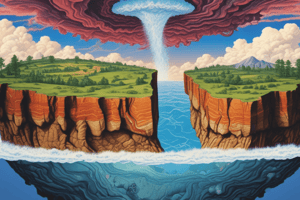Podcast
Questions and Answers
What is the depth range of the mantle?
What is the depth range of the mantle?
- 660 to 2,900 kilometers
- 30 to 2,900 kilometers (correct)
- 500 to 4,000 kilometers
- 30 to 1,800 kilometers
Which materials primarily compose the mantle?
Which materials primarily compose the mantle?
- Calcium and sodium minerals
- Granite and basalt
- Iron and nickel
- Silicate minerals rich in magnesium and iron (correct)
What is a key function of the mantle in Earth's geology?
What is a key function of the mantle in Earth's geology?
- Regulating atmospheric conditions
- Driving tectonic plate movements (correct)
- Generating Earth's magnetic field
- Stabilizing the Earth's crust
Which layer is part of the upper mantle?
Which layer is part of the upper mantle?
How does temperature change within the mantle?
How does temperature change within the mantle?
Flashcards are hidden until you start studying
Study Notes
What is the Mantle?
- The mantle is a significant layer of the Earth located between the crust and the outer core.
- It extends from about 30 kilometers (18.6 miles) deep to approximately 2,900 kilometers (1,800 miles) deep.
- Composed primarily of silicate minerals rich in magnesium and iron, the mantle is semi-solid and behaves like a viscous fluid over geological time scales.
Structure of the Mantle
-
Upper Mantle:
- Extends from the Moho (the boundary between the crust and the mantle) to about 660 kilometers (410 miles) deep.
- Includes the lithosphere (rigid upper part) and the asthenosphere (viscous, ductile layer allowing tectonic plate movement).
-
Lower Mantle:
- Extends from about 660 kilometers to the outer core at 2,900 kilometers (1,800 miles).
- Composed of denser materials and exhibits solid-state flow due to high pressure and temperature.
Properties
- Composition: Predominantly made up of olivine, pyroxene, garnet, and other silicate minerals.
- Temperature: Ranges from about 500 to 4,000 degrees Celsius (932 to 7,232 degrees Fahrenheit) increasing with depth.
- Pressure: Increases with depth, reaching over 1.5 million times atmospheric pressure at the lower mantle.
Functions
- Tectonic Activity: The convective movement in the mantle drives tectonic plate movements, causing earthquakes, volcanic activity, and mountain building.
- Heat Transfer: The mantle plays a crucial role in the Earth's thermal structure, transferring heat from the core to the surface.
Importance
- The mantle is vital for understanding Earth’s geology, including the formation of continents, ocean basins, and the dynamics of plate tectonics.
- Studying the mantle helps scientists learn about the Earth's history, composition, and the processes that shape the planet.
The Mantle
- Significant layer of Earth located between the crust and outer core.
- Extends from approximately 30 kilometers (18.6 miles) deep to around 2,900 kilometers (1,800 miles) deep.
- Composed mainly of silicate minerals rich in magnesium and iron, exhibiting semi-solid behavior.
Structure of the Mantle
- Upper Mantle:
- Extends from the Moho (boundary with the crust) to about 660 kilometers (410 miles) deep.
- Contains the lithosphere, the rigid upper section, and the asthenosphere, a ductile layer facilitating tectonic plate movement.
- Lower Mantle:
- Extends from about 660 kilometers deep to the outer core at 2,900 kilometers deep.
- Composed of denser materials, exhibiting solid-state flow under high pressure and temperature conditions.
Properties
- Composition: Predominantly composed of olivine, pyroxene, garnet, and other silicate minerals.
- Temperature: Ranges from roughly 500 to 4,000 degrees Celsius (932 to 7,232 degrees Fahrenheit), increasing with depth.
- Pressure: Pressure increases with depth, exceeding 1.5 million times atmospheric pressure in the lower mantle.
Functions
- Tectonic Activity: Convective movements in the mantle drive the movement of tectonic plates, leading to earthquakes, volcanic activity, and mountain formation.
- Heat Transfer: Plays a crucial role in transferring heat from the Earth's core to the surface, influencing climate and geological processes.
Importance
- Essential for understanding Earth's geology, including the development of continents, ocean basins, and plate tectonic dynamics.
- Studying the mantle provides insights into the Earth's history, materials, and the processes shaping the planet's evolution.
Studying That Suits You
Use AI to generate personalized quizzes and flashcards to suit your learning preferences.




